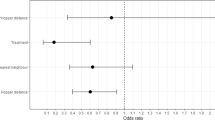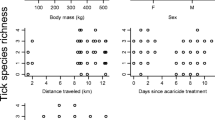Abstract
Haematobia irritans (L.) breeding in flood irrigated pastures of the lower Colorado Desert of southeastern California continues to remain unacceptably high during warm seasons (>1,000 adult flies per bovine head) despite the presence of moderately abundant populations ofOnthophagus gazella F. This study suggests that densities of > 40–70 adult beetles per dung pad and giving pronounced dung shredding activity, caused fly mortality of 38–56 %. The continued high abundance of adult horn flies on cattle suggests that at > 50% mortality, the pasture environment still produces sufficient flies to saturate cattle, although emigration might be reduced. Additional species of scarabs may be necessary to increase fly mortality. However, the dung drying activity of existingO. gazella significantly could interfere with resident staphylinid beetle breeding, which was significantly lower in pastures whereO. gazella reached densities of 40 per dung pad. Scarab beetle activity might also impede the introduction of superior predatory species for biological control.
Résumé
La multiplication d'Haematobia irritans (L.) dans les pâturages irrigués inondés du bas Colorado, désert sud-est de la Californie, continue à demeurer inacceptable durant les saisons chaudes (plus de 1 000 mouches adultes par tête de bovin) malgré la présence de populations moyennes d'Onthophagus gazella F. Cette étude suggère que des densités supérieures à 40/70 adultes de Scarabéide par bouse responsable d'une destruction prononcée de bouses, causaient une mortalité de 38 à 56% de mouches. La persistance d'une telle abondance de mouches adultes sur le bétail suggère qu'à plus de 50% de mortalité, l'environment des pâturages produit encore suffisamment de mouches pour saturer le bétail, bien que l'émigration puisse être réduite. Des espèces supplémentaires de Scarabéides peuvent être nécessaires pour augmenter la mortalité des mouches. Cependant, l'activité de dessication des boues due auxO. gazella existant pourrait interférer avec la multiplication des staphylinides résidents qui était significativement plus faibles dans les pâturages oùO. gazella atteignait des densités de 40 individus/bouse. L'activité des Scarabéides peut aussi entraver l'introduction d'espèces prédatrices supérieures pour la lutte biologique.
Similar content being viewed by others
References
Anderson, J. R. &Loomis, E. C. — 1978. Exotic dung beetles in pasture and range land ecosystems. —Calif. Agric., 32, 31–32.
Blume, R. R., Kunz, S. E., Hogan, B. F. &Matter, J. J. — 1970. Biological and ecological investigations of horn flies in central Texas: influence of other insects in cattle manure. —J. Econ. Entomol., 63, 1121–1123.
Blume, R. R., Matter, J. M. &Eschle, J. L. — 1973.Onthophagus gazella: effect on survival of horn flies in the laboratory. —Environ. Entomol., 2, 811–813.
Bornemissza, G. F. — 1960. Could dung eating insects improve our pastures? —J. Aust. Inst. Agric. Sci., 26, 54–56.
Bornemissza, G. F. — 1968. Studies on the histerid beetlePachylister chinensis in Fiji and its possible value in the control of buffalo-fly in Australia. —Aust. J. Zool., 16, 673–688.
Bornemissza, G. F. — 1970. Insectary studies on the control of dung breeding flies by the activity of the dung beetle,Onthophagus gazella F. [Coleoptera: Scarabaeinae]. —J. Aust. Entomol. Soc., 9, 31–41.
Ferrar, P. — 1975. Disintegration of dung pads in North Queensland before the introduction of exotic dung beetles. —Aust. J. Expt. Agric. Anim. Husb., 15, 325–329.
Fincher, G. T. — 1981. The potential value of dung beetles in pasture ecosystems. —J. Georgia Entomol. Soc., 16, Suppl. 1, 316–333.
Fincher, G. T., Monson, W. G. &Burton, G. W. — 1981. Effects of cattle feces rapidly buried by dung beetles on yield and quality of coastal Bermudagrass. —Agronomy J., 73, 775–779.
Hughes, R. D., Woolcock, L. T. &Ferrar, P; — 1974. The selection of natural enemies for the biological control of the Australian bushfly. —J. Appl. Ecol., 11, 483–488.
Hughes, R. D., Tyndle-Biscoe, M. &Walker, J. — 1978. Effects of introduced dung beetles [Coleoptera: Scarabaeidae] on the breeding and abundance of the Australian bush fly,Musca vetustissima Walker [Diptera: Muscidae]. —Bull. Entomol. Res., 68, 361–372.
Kessler, K. — 1983. Million-dollar manure spreaders. —The Furrow, 88, 28–29.
Legner, E. F. — 1978a. Natural enemies imported in California for the biological control of face fly,Musca autumnalis De Geer, and horn fly,Haematobia irritans (L.). —Proc. Calif. Mosq. & Vect. Contr. Assoc., Inc., 46, 77–79.
Legner, E. F. — 1978b. Part I: Parasites and Predators Introduced Against Arthropod Pests. Diptera.In: Introduced Parasites and Predators of Arthropod Pests and Weeds: a World Review (C. P. Clausen, edit.), pp. 335–339; 346–355. —Agric. Handb. No. 480,ARS, USDA, U.S. Govt. Printing Off., Wash. D.C., 454 pp.
Legner, E. F. — 1986. The requirement for reassessment of interactions among dung beetles, symbovine flies, and natural enemies. —Entomol. Soc. Amer. Misc. Publ., 61, 120–131.
Legner, E. F. &Moore, I. — 1977. The larva ofPlatystethus spiculus Erichson [Coleoptera: Staphylinidae] and its occurrence in bovine feces in irrigated pastures. —Psyche, 84, 158–164.
Legner, E. F. &Olton, G. S. — 1969. Migrations ofHippelates collusor larvae from moisture and trophic stimuli and their encounter byTrybliographa parasites. —Ann. Entomol. Soc. Amer., 62, 136–141.
Macqueen, A. — 1975. Dung as an insect food source: dung beetles as competitors of other coprophagous fauna and as targets for predators. —J. Appl. Ecol., 12, 821–827.
Moon, R. D., Loomis, E. C. &Anderson, J. R. — 1980. Influence of two species of dung beetles on larvae of face fly. —Environ. Entomol., 9, 607–612.
Ridsdill-Smith, T. J. — 1981. Some effects of three species of dung beetles [Coleoptera: Scarabaeidae] in south-western Australia on the survival of the bush fly,Musca vetustissima Walker [Diptera: Muscidae], in dung pads. —Bull. Entomol. Res., 71, 425–433.
Ridsdill-Smith, T. J. &Matthiessen, J. N.; — 1984. Field assessments of the impact of night-flying dung beetles [Coleoptera: Scarabaeidae] on the bush fly,Musca vetustissima Walker [Diptera: Muscidae], in south-western Australia. —Bull. Entomol. Res. 74, 191–195.
Ridsdill-Smith, T. J., Matthiessen, J. N. &Mahon, J. A. — 1977. New approaches to dung beetle and bush fly research in south-western Australia. —Proc. Western Australia Entomology Workshop, Dec., 2, 1977, pp. 16–19.
Roth, J. P., Fincher, G. T. &Summerlin, J. W. — 1983. Competition and predation as mortality factors of the horn fly,Haematobia irritans (L.) [Diptera: Muscidae] in a central Texas pasture habitat. —Environ. Entomol., 12, 106–109.
Steel, R. G. D. &Torrie, J. H. — 1980. Principles and Procedures of Statistics, 2nd Edition. —Mc Graw-Hill Book Co., Inc. N. Y..
Tyndale-Biscoe, M., Wallace, M. M. H. &Morton, R. — 1981. Arthropod-induced mortality in immature stages of the bush fly,Musca vetustissima Walker [Diptera: Muscidae]. —Bull. Entomol. Res., 71, 681–690.
Wallace, M. M. H. &Tyndale-Biscoe, M. — 1983. Attempts to measure the influence of dung beetles [Coleoptera: Scarabaeidae] on the field mortality of the bush flyMusca vetustissima Walker [Diptera: Muscidae] in south-eastern Australia. —Bull. Entomol. Res., 73, 33–44.
Waterhouse, D. F. — 1974. The biological control of dung. —Scien. Amer., 230, 100–109.
Author information
Authors and Affiliations
Rights and permissions
About this article
Cite this article
Legner, E.F., Warkentin, R.W. Influence ofOnthophagus gazella on hornfly,Haematobia irritans density in irrigated pastures. Entomophaga 36, 547–553 (1991). https://doi.org/10.1007/BF02374437
Received:
Accepted:
Issue Date:
DOI: https://doi.org/10.1007/BF02374437




